Luminosity (bolometric) 37,875 L☉ | Magnitude 3.04 | |
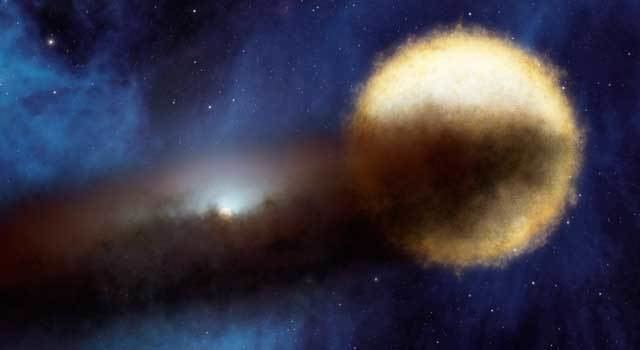 | ||
Similar Zeta Aurigae, Beta Aurigae, Capella, UU Aurigae, Theta Aurigae | ||
Epsilon Aurigae (ε Aur, ε Aurigae) is the Bayer designation for a star in the northern constellation of Auriga. It is traditionally known as Almaaz, Haldus, or Al Anz. Epsilon Aurigae is an unusual eclipsing binary system comprising an F0 supergiant and a companion which is generally accepted to be a huge dark disk orbiting an unknown object, possibly a binary system of two small B-type stars. About every 27 years, Epsilon Aurigae's brightness drops from an apparent visual magnitude of +2.92 to +3.83. This dimming lasts 640–730 days. In addition to this eclipse, the system also has a low amplitude pulsation with a non-consistent period of around 66 days. The distance to the system is still a subject of debate, but modern estimates place it approximately 2,000 light years from Earth.
Contents
- Introduction to epsilon aurigae
- Observational history
- Spitzer observations 2009
- Nature of the system
- Visible component
- Eclipsing component
- Observation
- Citizen Sky
- Etymology
- References
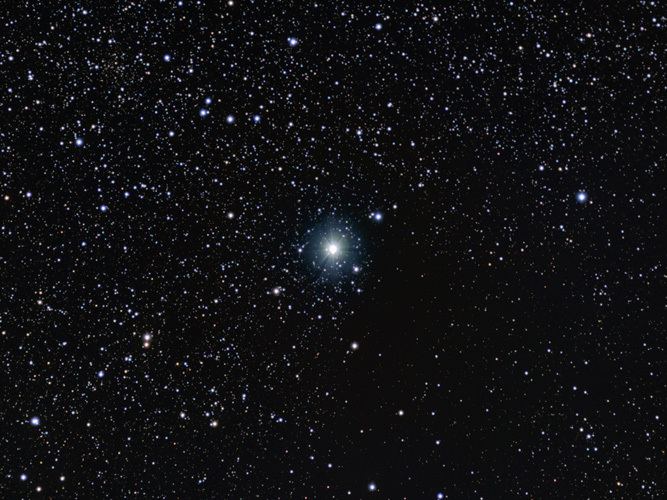
Epsilon Aurigae was first suspected to be a variable star when German astronomer Johann Heinrich Fritsch observed it in 1821. Later observations by Eduard Heis and Friedrich Wilhelm Argelander reinforced Fritsch's initial suspicions and attracted attention to the star. Hans Ludendorff, however, was the first to study it in great detail. His work revealed that the system was an eclipsing binary variable, a star that dims when its partner obscures its light.
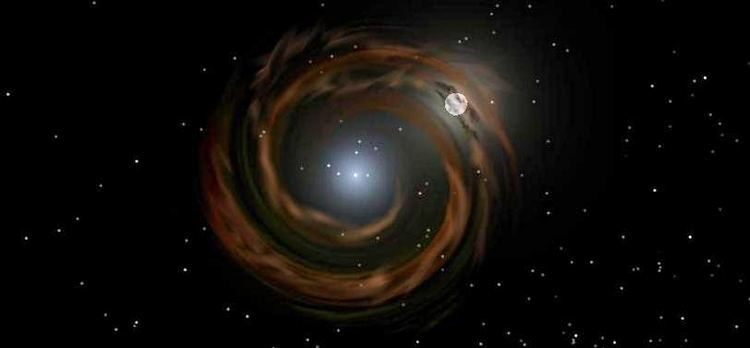
Epsilon Aurigae's eclipsing companion has been subject to much debate since the object does not emit as much light as is expected for an object its size. As of 2008, the most popularly accepted model for this companion object is a binary star system surrounded by a massive, opaque disk of dust; theories speculating that the object is a large, semitransparent star or a black hole have since been discarded.
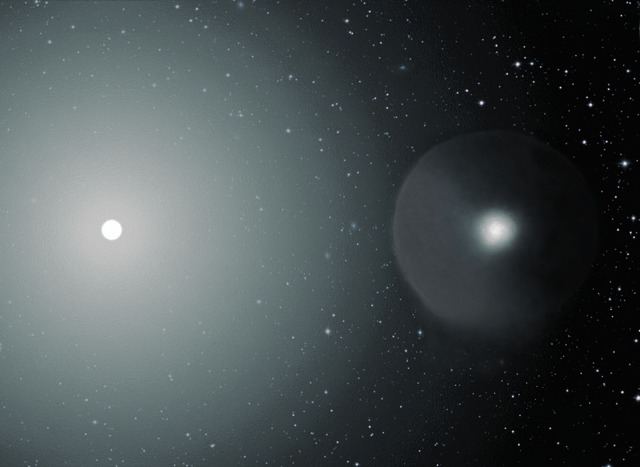
Introduction to epsilon aurigae
Observational history

Although the star is easily visible to the naked eye, Johann Fritsch's 1821 observations suggest he was the first to notice that the system was a variable. Eventually, from 1842 to 1848, German mathematician Eduard Heis and Prussian astronomer Friedrich Wilhelm Argelander began observing it once every few years. Both Heis' and Argelander's data revealed that the star had become significantly dimmer by 1847, attracting the full attention of both men at that point. Epsilon Aurigae had brightened significantly, and had returned to "normal" by the following September. As it attracted more attention, more and more data was compiled. The observational data revealed that Epsilon Aurigae did not just vary over a long period, but also experienced short-term variations in brightness as well. Later eclipses took place between 1874 and 1875 and, nearly thirty years later, between 1901 and 1902.
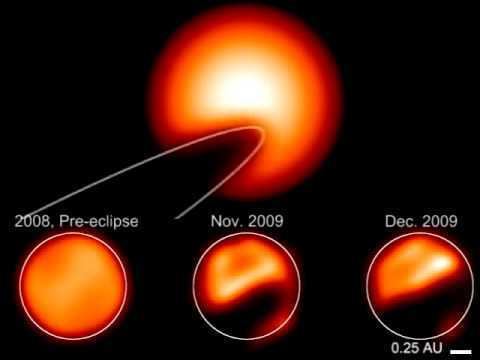
Hans Ludendorff, who had also been observing Epsilon Aurigae, was the first to conduct a detailed study of the star. In 1904, he published in Astronomische Nachrichten an article titled Untersuchungen über den Lichtwechsel von ε Aurigae (Investigations of the Light Changes of Epsilon Aurigae), where he suggested the star was an Algol variable and an eclipsing binary.
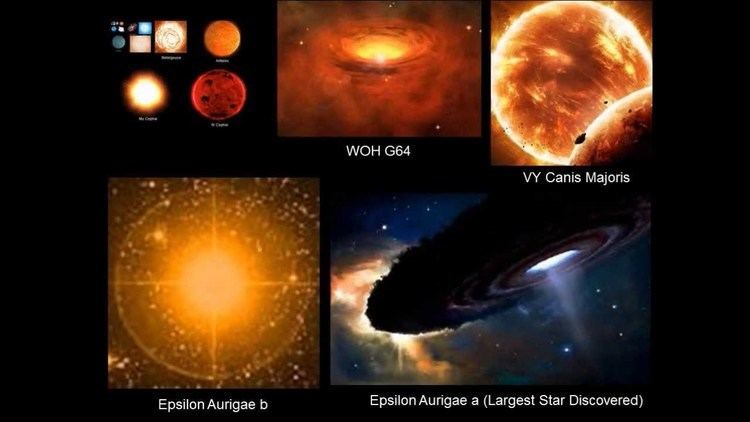
Epsilon Aurigae was targeted for observation by International Year of Astronomy observers from 2009 to 2011, the three years that overlapped its most recent eclipse.
Spitzer observations, 2009
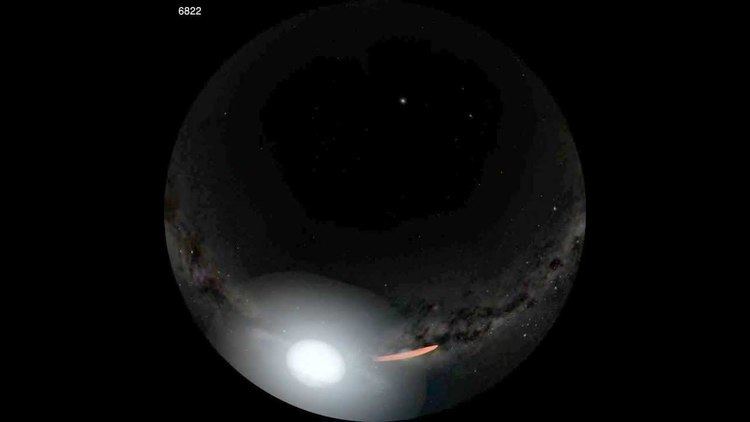
At the January 2010 meeting of the American Astronomical Society, Donald Hoard of NASA's Spitzer Science Center at the California Institute of Technology in Pasadena reported that observations from NASA's Spitzer Space Telescope along with earlier observations point to the primary being a post-asymptotic giant branch star with about 2.2–3.3 times the mass of the Sun periodically eclipsed by just a single B class star inside a disk. This was accomplished by pointing Spitzer at the star using the corner of four of Spitzer's pixels, instead of directly at one, to effectively reduce the telescope's sensitivity and preventing the star from overloading it, then using exposures of one-hundredth of a second, the shortest duration images that can be obtained by Spitzer. The data supports the presence of the companion star's disk, and establish the particle sizes as being like gravel rather than like fine dust.
Nature of the system
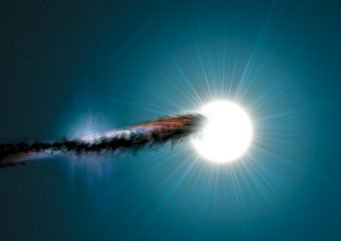
The nature of the Epsilon Aurigae system has always been unclear. It has long been known to consist of at least two components which undergo periodic eclipses with an unusual flat-bottomed dimming every 27 years. Early explanations with exceptionally large diffuse stars, black holes, and odd doughnut-shaped discs are no longer accepted. There are now two main explanations that can account for the known observed characteristics: a high mass model where the primary is a yellow supergiant of around 15 M☉; and a low mass model where the primary is about 2 M☉ and a less luminous evolved star.
Variations on the high mass model have always been popular, since the primary star is to all appearances a large supergiant star. Spectroscopically it is early F or late A with luminosity class Ia or Iab. Distance estimates consistently lead to luminosities expected for a bright supergiant. One exception is the Hipparcos parallax measurement, but the margin of error is as large as the value itself and so the derived distance is likely to be anything from 355-4167pc. The main problem with this model is the nature of the secondary, which is required to have a mass about the same as the primary, at odds with observations where it appears as a B-type main sequence star. The secondary may be a close binary involving two lower-mass main sequence stars, or a more complex system.
The low mass model, recently popularised by the Citizen Sky project, proposes that the primary is an evolved asymptotic giant branch star of 2–4 M☉. This relies on distance and luminosity estimates lower than most observations. The star would be an unusually large and bright giant star for the given mass, possibly as the result of very high mass loss. To match the observed eclipse and orbital data, the secondary is a fairly normal B main sequence star of about 6 M☉ embedded in a thick disc seen nearly edge on.
The orbit itself is now fairly well determined, inclined at over 87 degrees to Earth. The primary and the disk are nearly thirty AU apart, (in the high mass model) which is approximately the distance of the planet Neptune from the Sun.
Visible component
The visible component, Epsilon Aurigae A, is a semiregular pulsating post-asymptotic giant branch star belonging to the spectral class F0. This F-type star has around 135 to 190 times the diameter of the Sun, and is 70,000 to 80,000 times as luminous. (Reliable sources vary considerably in their estimates of both quantities.) If the star were in the position of the Sun, it would envelop Mercury and possibly Venus. F-type stars like Epsilon Aurigae tend to glow white and display strong ionized calcium absorption lines and weak hydrogen absorption lines; being a class above the Sun (which is a G-type star), F-type stars are typically hotter than sunlike stars. Other F-type stars include Procyon's primary star, the brightest star in the Canis Minor constellation; and Canopus, the second brightest star in the night sky and the brightest star in the Carina constellation.
Eclipsing component
The eclipsing component emits a negligible amount of light, and is not visible to the naked eye. A heated region, however, has been discovered in the center of the object. The exact form of Epsilon Aurigae's eclipsing component is not known. Hypotheses concerning the nature of this second object have been proposed, three of which have garnered attention from the scientific community.
The first hypothesis, set forth in 1937 by astronomers Gerard Kuiper, Otto Struve, and Bengt Strömgren, suggested that Epsilon Aurigae was a binary star system containing an F2 supergiant and an extremely cool "semitransparent" star that would completely eclipse its companion. However, the eclipsing star would scatter light emitted by its eclipsed companion resulting in the observed decrease in magnitude. The scattered light would be detected on Earth as a star visible to the naked eye, although this light would be significantly dimmed. However, astronomer Su-Shu Huang published a paper in 1965 that outlined the defects of the Kuiper-Struve-Strömgren model, and proposed that the companion is a large disk system, edge-on from the perspective of Earth. Robert Wilson, in 1971, proposed that a "central opening" lay in the disk, a possible reason for the system's sudden brightening midway through the eclipse. In 2005, the system was observed in the ultraviolet by the Far Ultraviolet Spectroscopic Explorer (FUSE); as the star system was not emitting energy at rates characteristic of objects such as the neutron star binary system Circinus X-1 or black hole binary system Cygnus X-1, the object occupying the center of the disk is not expected to be anything of the sort; in contrast, a new hypothesis has suggested that the central object is actually a B5-type star.
Observation
The star is easily found because of its brightness and apparent proximity to the star Capella. It is the apex of the isosceles triangle forming the 'nose' of the constellation Auriga. The star is bright enough to be seen from most urban locations with moderate amounts of light pollution. Visual variable star observers make an estimate of its brightness by comparing its brightness with nearby stars with a known brightness value.
Citizen Sky
The National Science Foundation has awarded the AAVSO a three-year grant to fund a citizen science project built around the 2009-2011 eclipse. The project, called Citizen Sky, is organizing and training participants to observe the eclipse and report their data to a central database. In addition, participants will help validate and analyze the data while testing their own theories and publishing original research articles in a peer-reviewed astronomical journal.
Etymology
"Epsilon Aurigae" is the system's Bayer designation (invented by German astronomer Johann Bayer in his 1603 atlas, Uranometria). The star is also known colloquially as Almaaz, Haldus or Al Anz. Both Almaaz and Al Anz derive from the Arabic اَلْمَاعَزْ al-mācz ((billy) goat), corresponding to the name of the star Capella (Latin for "nanny goat").
In Chinese, 柱 (Zhù), meaning Pillars, refers to an asterism consisting of ε Aurigae, ζ Aurigae, η Aurigae, υ Aurigae, ν Aurigae, τ Aurigae, χ Aurigae and 26 Aurigae. Consequently, ε Aurigae itself is known as 柱一 (Zhù yī, "First Star of Pillars").
